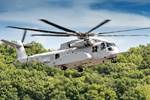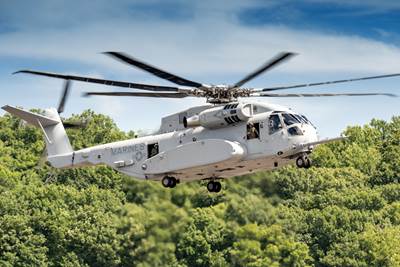Swiss Air-Rescue Service Rega orders 12 additional five-bladed H145s from Airbus
The order will replace Rega’s current fleet of AW109SP helicopters used for critical air rescue services in its mountain bases, adds to the company’s anticipated 2026 all-Airbus fleet.
Share
Read Next
The Swiss Air-Rescue Service Rega (Zürich) has ordered a second batch of 12 five-bladed Airbus (Toulouse, France) H145 helicopters to be operated from its mountain bases. The aircraft, with a “bearingless main rotor system featur[ing] a fully composite flex-beam and main rotor blades” according to Vertical Magazine, will replace the current fleet of AW109SP helicopters. This new order follows an initial contract for nine H145s, announced in March this year. By 2026, Rega will operate an all-Airbus fleet consisting of 21 five-bladed H145s.
“To effectively operate life-saving air rescue services in Switzerland, we understand that the ability to perform optimally at altitude is paramount,” Bruno Even, CEO of Airbus Helicopters, says. “The five-bladed H145 landed on the Aconcagua in Chile, a mountain that is nearly 7,000 metres high — no other twin engine helicopter has ever achieved this feat. That is why we are especially proud that Rega has put its faith in the five-bladed H145 and decided to make it the only helicopter type in its fleet to perform such critical missions.”
Ernst Kohler, CEO of Rega, says the decision will ensure that Rega continues providing its patients with “reliable and professional medical assistance by air for the next 15 years.”
The five-bladed H145s will come equipped with a state-of-the-art navigation system, especially tailored to the operator’s needs that will enhance the mission capabilities and the safety of operations. The system will use new capabilities of the Flight Management System GTN750 Xi by Garmin. It will integrate and control a multi-sensor system that provides highly accurate and reliable navigation capacities. Even in the event of GPS signal loss, Airbus says the helicopter will navigate safely thanks to Thales’ inertial navigation system. This solution will further boost the navigation performance in low IFR conditions and enables the helicopter to be certified as navigation procedure RNP-AR 0.1, which is reported to be the most accurate navigation procedure in the helicopter environment. The configuration also includes a new hoist by Vincorion that is being certified on the five-bladed H145, ensuring highest safety standards.
Rega operates 14 HEMS stations in Switzerland. Last year, the helicopter crews carried out 14,330 missions, including transporting 471 COVID-19 patients.
The new version of Airbus’ best-selling H145 light twin-engine helicopter adds a new, innovative five-bladed rotor to the multi-mission aircraft, increasing the useful load of the helicopter by 150 kilograms. The simplicity of the new bearingless main rotor design also eases maintenance operations, further improving the benchmark serviceability and reliability of the H145, while improving ride comfort for both passengers and crew.
In total, there are more than 1,600 H145 family helicopters in service, logging a total of more than seven million flight hours. Powered by two Safran (Paris, France) Arriel 2E engines, the H145 is equipped with full authority digital engine control (FADEC) and the Helionix digital avionics suite. It includes a high-performance four-axis autopilot, increasing safety and reducing pilot workload. Its particularly low acoustic footprint makes the H145 the quietest helicopter in its class, while its CO2 emissions are the lowest amongst its competitors, Airbus contends.
Related Content
Welding is not bonding
Discussion of the issues in our understanding of thermoplastic composite welded structures and certification of the latest materials and welding technologies for future airframes.
Read MoreManufacturing the MFFD thermoplastic composite fuselage
Demonstrator’s upper, lower shells and assembly prove materials and new processes for lighter, cheaper and more sustainable high-rate future aircraft.
Read MorePlant tour: Joby Aviation, Marina, Calif., U.S.
As the advanced air mobility market begins to take shape, market leader Joby Aviation works to industrialize composites manufacturing for its first-generation, composites-intensive, all-electric air taxi.
Read MoreASCEND program update: Designing next-gen, high-rate auto and aerospace composites
GKN Aerospace, McLaren Automotive and U.K.-based partners share goals and progress aiming at high-rate, Industry 4.0-enabled, sustainable materials and processes.
Read MoreRead Next
Airbus reports solid Q1 2022 results, forecasts 720 commercial aircraft deliveries by end of year
Reflects solid performance across commercial aircraft, helicopter and defense businesses with 142 aircraft delivered in Q1, with developing activities for A321XLR, A320 Family and A400M.
Read MoreSikorsky delivers third CH-53K helicopter to U.S. Marine Corps
This is the third out of seven composites-intensive heavy-lift helicopters that have been delivered to the fleet exceeding all DOD rotary wing platforms, created in a complete, digital environment.
Read MorePlant tour: Daher Shap’in TechCenter and composites production plant, Saint-Aignan-de-Grandlieu, France
Co-located R&D and production advance OOA thermosets, thermoplastics, welding, recycling and digital technologies for faster processing and certification of lighter, more sustainable composites.
Read More


























